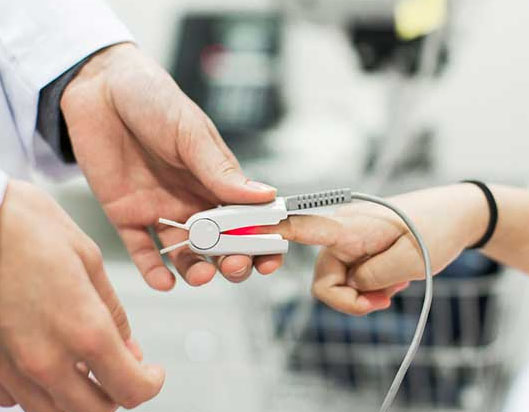Blood oxygen levels refer to the amount of oxygen that is being carried by the red blood cells in the bloodstream. Oxygen is crucial for the proper functioning of the body’s organs and tissues, as it is needed for cellular respiration, which generates energy. Blood oxygen levels are important for overall health because low oxygen levels can cause a range of health problems, including shortness of breath, fatigue, dizziness, confusion, and even organ failure. Oxygen levels can be affected by a variety of factors, including lung disease, heart disease, altitude, and more.
Table of Contents
Blood Oxygen Monitor
Blood oxygen monitors, also known as pulse oximeters, is a device that measures the oxygen saturation levels in the blood. It is a non-invasive device that typically attaches to a finger, toe, or earlobe to measure the amount of oxygen that is being carried by the red blood cells.
Blood oxygen monitors work by emitting light that passes through the tissue and is absorbed by the oxygenated and deoxygenated hemoglobin in the blood. The amount of light absorbed by the blood is then used to calculate the oxygen saturation level.
Blood oxygen monitors are commonly used by healthcare professionals in hospitals, clinics, and emergency rooms to monitor patients with respiratory or cardiac conditions. They are also available for personal use and can be used to monitor oxygen levels at home or while exercising.
There are several types of blood oxygen monitors available on the market, ranging from simple finger pulse oximeters to more advanced wearable devices that track oxygen levels continuously. Some monitors also have additional features, such as heart rate monitoring and sleep tracking.
What is SpO2 and how is it measured?
SpO2, or peripheral capillary oxygen saturation, is a measure of the percentage of hemoglobin in red blood cells that is bound to oxygen. This measurement is used to determine the oxygen saturation level in the blood.
SpO2 is typically measured using spO2 monitor, which is a small device that is attached to a finger, toe, or earlobe. The pulse oximeter uses two wavelengths of light to measure the amount of oxygen in the blood. The device emits light that passes through the tissue and is absorbed by the oxygenated and deoxygenated hemoglobin in the blood. The amount of light absorbed by the blood is then used to calculate the oxygen saturation level.
SpO2 levels are expressed as a percentage, with normal levels ranging between 95% and 100%. Levels below 95% may indicate hypoxemia, which is a low level of oxygen in the blood. Hypoxemia can be caused by a variety of factors, including lung disease, heart disease, anemia, and more. In addition to measuring oxygen saturation levels, pulse oximeters can also measure heart rate, making them useful for monitoring patients with respiratory or cardiac conditions. Pulse oximeters are also commonly used in hospitals, emergency rooms, and clinics to monitor patients during surgery or other medical procedures.
Understanding Normal Blood Oxygen Levels
Normal blood oxygen levels typically range between 95% and 100%. However, some individuals may have slightly lower oxygen saturation levels. Normal oxygen levels can vary depending on factors like age and activity level. For example, older adults may have slightly lower oxygen levels, while athletes may have slightly higher levels.
Factors Affecting Blood Oxygen Levels
A variety of factors can affect blood oxygen levels. These include lung disease, heart disease, anemia, altitude, sleep apnea, obesity, and more. Lung disease, such as chronic obstructive pulmonary disease (COPD) or asthma, can reduce the amount of oxygen that is able to enter the bloodstream. Anemia, which is a condition where there are not enough red blood cells, can also lead to low oxygen levels. Altitude can affect oxygen levels because the air is thinner at higher elevations, which can make it harder to breathe.
Interpreting Blood Oxygen Level Results Interpreting blood oxygen level results involves understanding what different oxygen saturation levels mean and what factors can affect the accuracy of the results. Oxygen saturation levels can be affected by factors like carbon monoxide poisoning or low blood pressure. It is important to understand the context in which the oxygen saturation levels were measured, such as the patient’s medical history and current health status.
Tips for Maintaining Healthy Blood Oxygen Levels
Maintaining healthy blood oxygen levels involves taking steps to protect lung health, such as quitting smoking, staying active, managing underlying health conditions, and avoiding exposure to air pollution and other irritants. Regular exercise, healthy eating, and staying hydrated can also help maintain healthy oxygen levels.
Conclusion
The Importance of Monitoring Blood Oxygen Levels Monitoring blood oxygen levels is important for overall health because low oxygen levels can lead to a range of health problems. Understanding how to measure and interpret oxygen saturation levels with the best pulse oximeters can help individuals take steps to maintain healthy levels and seek medical attention if necessary. By following a healthy lifestyle and managing underlying health conditions, individuals can help ensure that their blood oxygen levels remain within a healthy range.



















